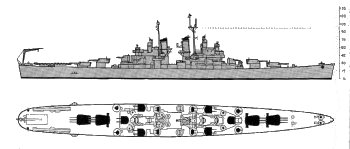![]() The Pacific War Online Encyclopedia
The Pacific War Online Encyclopedia
|
| Previous: Clemson Class, U.S. Destroyers | Table of Contents | Next: Clipperton Island |
 ONI 222 |
|
Tonnage |
11,700 tons standard |
|
Dimensions |
610' by 66'3" by 24'7" 185.93m by 20.19m by 7.49m |
|
Maximum speed |
32.5 knots |
|
Complement |
1285 |
| 2 catapults 4 seaplanes |
|
|
Armament |
4x3 6"/47
guns 6x2 5"/38 dual purpose guns 4x2 40mm Bofors AA guns 13x1 20mm Oerlikon AA guns |
| 1468 tons: 5" (127mm) machinery belt tapering to 3.3" (83mm) backed by 0.5" (16mm) STS plating 5" (127mm) machinery bulkheads tapering to 2" (51mm) 2" (51mm) forward magazine belt 4.7" (120mm) aft magazine belt 3.7" (93mm) magazine bulkheads 2" (51mm) armor deck 6" (152mm) barbettes 6"/3"/3"/1.3" (152mm/76mm/76mm/32mm) turret face/roof/side/rear 1.3" (32mm) secondary guns 5" (130 mm) conning tower (first nine units only) Triple bottom Double bottom to armored deck enclosing magazines |
|
| Immune zones |
9,500 to 22,000 yards against 6" shells |
| Machinery |
4-shaft General Electric
geared
turbines (100,000 shp) 4 Babcock & Wilcox boilers |
|
Bunkerage |
2100 tons fuel oil |
|
Range |
11,000 nautical miles (20,000 km) at 15 knots |
| Sensors |
SC
radar |
| Modifications |
Highly variable by unit. 1942-11: Light antiaircraft increased to 4x2, 2x4 40mm guns. All units equipped with SG and
FC radar
by 1943-6. 1944-5: Light antiaicraft increased to
6x2,
4x4 40mm guns, 10x1 20mm
Oerlikon AA guns One catapult removed late in the war. |
The Clevelands
were completed in 1942-45. Based largely on the Brooklyns,
these were
excellent ships, with good firepower, protection, and basic
toughness. The
second Houston survived two torpedo
hits that
resulted in over 9000 tons
of flooding, a remarkable demonstration of hull strength.
Their machinery was
well-dispersed and they were very maneuverable. Their
greatest weakness, which
they shared with too many other American designs, was that they
were
top heavy.
Perhaps this explains why members of other services often referred
to
American
sailors as "pukes."
The design went back to 1938, when the tentative
FY40 program called for two 8000-ton cruisers. The projected
numbers
went up as the world crisis deepened, and by May 1939 the features
being demanded had evolved beyond what could be fit on an 8000-ton
displacement. The outbreak of war in Europe effectively ended the
treaty
limitations,
and new cruisers were needed in a hurry, leading to a decision on
2
October 1939 to base the new ships on Helena,
the final Brooklyn to be
completed. The most visible difference was the replacement of one
main
turret with an additional pair of heavy antiaircraft turrets.
Stability
concerns also required a larger beam.
None were lost in combat, though, as previously
noted, Houston came very
close to being lost off Formosa.
Several units of this class were converted on the ways to Independence-class light carriers.
| arrived 1942-11-14 |
|
| arrived 1942-12-10 | |
| arrived 1943-1-1 | |
| arrived 1943-1-29 | |
| arrived 1943-3-14 | |
| arrived 1943-7-16 | |
| arrived 1943-8-31 | |
| arrived 1943-12 | |
| arrived 1944-4-23 | |
| arrived 1944-4-23 | |
| arrived 1944-4-23 | |
| arrived 1944-10-2 | |
| arrived 1944-10-27 | |
| arrived 1944-12-1 | |
| arrived 1945-1-11 | |
| arrived 1945-2-5 | |
| arrived 1945-4 | |
| arrived 1945-4-1 | |
| arrived 1945-4-19 | |
| arrived 1945-4-25 | |
| arrived 1945-5 | |
| arrived 1945-6-1 |
 |
 |
 |
 |
 |
 |
 |
References
Gogin
(2008; accessed 2012-11-24)
The Pacific War Online Encyclopedia © 2007, 2009, 2012-2013, 2016 by Kent G. Budge. Index